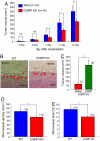Neuronal system-dependent facilitation of tumor angiogenesis and tumor growth by calcitonin gene-related peptide
- PMID: 18757746
- PMCID: PMC2527353
- DOI: 10.1073/pnas.0800767105
Neuronal system-dependent facilitation of tumor angiogenesis and tumor growth by calcitonin gene-related peptide
Abstract
A neuropeptide, calcitonin gene-related peptide (CGRP), is widely distributed in neuronal systems and exhibits numerous biological activities. Using CGRP-knockout mice (CGRP(-/-)), we examined whether or not endogenous CGRP facilitates angiogenesis indispensable to tumor growth. CGRP increased tube formation by endothelial cells in vitro and enhanced sponge-induced angiogenesis in vivo. Tumor growth and tumor-associated angiogenesis in CGRP(-/-) implanted with Lewis lung carcinoma (LLC) cells were significantly reduced compared with those in wild-type (WT) mice. A CGRP antagonist, CGRP8-37 or denervation of sciatic nerves (L(1-5)) suppressed LLC growth in the sites of denervation compared with vehicle infusion or sham operation. CGRP precursor mRNA levels in the dorsal root ganglion in LLC-bearing WT were increased compared with those in non-LLC-bearing mice. This increase was abolished by denervation. The expression of VEGF in tumor stroma was down-regulated in CGRP(-/-). These results indicate that endogenous CGRP facilitates tumor-associated angiogenesis and tumor growth and suggest that relevant CGRP may be derived from neuronal systems including primary sensory neurons and may become a therapeutic target for cancers.
Conflict of interest statement
The authors declare no conflict of interest.
Figures




Similar articles
-
Calcitonin gene-related peptide facilitates revascularization during hindlimb ischemia in mice.Am J Physiol Heart Circ Physiol. 2011 Feb;300(2):H431-9. doi: 10.1152/ajpheart.00466.2010. Epub 2010 Dec 3. Am J Physiol Heart Circ Physiol. 2011. PMID: 21131474
-
Roles of calcitonin gene-related peptide in facilitation of wound healing and angiogenesis.Biomed Pharmacother. 2008 Jul-Aug;62(6):352-9. doi: 10.1016/j.biopha.2008.02.003. Epub 2008 Mar 6. Biomed Pharmacother. 2008. PMID: 18430544
-
Analysis of the cellular expression pattern of beta-CGRP in alpha-CGRP-deficient mice.J Comp Neurol. 2004 Aug 9;476(1):32-43. doi: 10.1002/cne.20211. J Comp Neurol. 2004. PMID: 15236465
-
Butyrate sensitizes the release of substance P and calcitonin gene-related peptide evoked by capsaicin from primary cultured rat dorsal root ganglion neurons.Neuro Endocrinol Lett. 2006 Dec;27(6):695-701. Neuro Endocrinol Lett. 2006. PMID: 17187013
-
Calcitonin gene-related peptide (CGRP): A novel target for Alzheimer's disease.CNS Neurosci Ther. 2017 Jun;23(6):457-461. doi: 10.1111/cns.12696. Epub 2017 Apr 17. CNS Neurosci Ther. 2017. PMID: 28417590 Free PMC article. Review.
Cited by
-
A Novel α-Calcitonin Gene-Related Peptide Analogue Protects Against End-Organ Damage in Experimental Hypertension, Cardiac Hypertrophy, and Heart Failure.Circulation. 2017 Jul 25;136(4):367-383. doi: 10.1161/CIRCULATIONAHA.117.028388. Epub 2017 Apr 26. Circulation. 2017. PMID: 28446517 Free PMC article.
-
Lack of RAMP1 Signaling Suppresses Liver Regeneration and Angiogenesis Following Partial Hepatectomy in Mice.In Vivo. 2024 Sep-Oct;38(5):2261-2270. doi: 10.21873/invivo.13691. In Vivo. 2024. PMID: 39187322 Free PMC article.
-
Acidic microenvironment and bone pain in cancer-colonized bone.Bonekey Rep. 2015 May 6;4:690. doi: 10.1038/bonekey.2015.58. eCollection 2015. Bonekey Rep. 2015. PMID: 25987988 Free PMC article. Review.
-
Comprehensive Analysis of Inflammatory Response-Related Genes, and Prognosis and Immune Infiltration in Patients With Low-Grade Glioma.Front Pharmacol. 2021 Oct 12;12:748993. doi: 10.3389/fphar.2021.748993. eCollection 2021. Front Pharmacol. 2021. PMID: 34712139 Free PMC article.
-
Breast cancer induced nociceptor aberrant growth and collateral sensory axonal branching.Oncotarget. 2017 Sep 1;8(44):76606-76621. doi: 10.18632/oncotarget.20609. eCollection 2017 Sep 29. Oncotarget. 2017. PMID: 29100335 Free PMC article.
References
-
- Patrick W, et al. Molecular mechanisms of cancer pain. Nat Rev Cancer. 2002;2:2001–2209. - PubMed
-
- Direkze NC, et al. Bone marrow-derived stromal cells express lineage-related messenger RNA species. Cancer Res. 2006;66:1265–1269. - PubMed
-
- Rao G, et al. Facilitating role of preprotachykinin-I gene in the integration of breast cancer cells within the stromal compartment of the bone marrow: A model of early cancer progression. Cancer Res. 2004;1564:2874–2881. - PubMed
-
- Mukouyama YS, Shin D, Brittisch S, Taniguchi M, Anderson DJ. Sensory nerves determine the pattern of arterial differentiation and blood vessel branching in the skin. Cell. 2002;109:693–705. - PubMed
-
- Miller G. Developmental biology: Nerves tell arteries to make like a tree. Science. 2002;296:2121–2123. - PubMed
Publication types
MeSH terms
Substances
LinkOut - more resources
Full Text Sources
Other Literature Sources
Molecular Biology Databases
Research Materials

